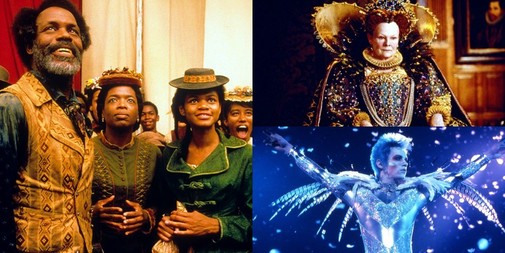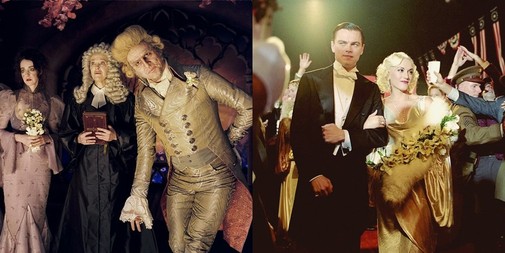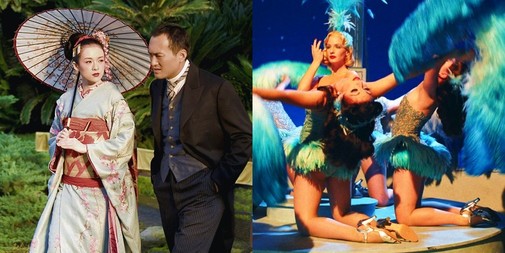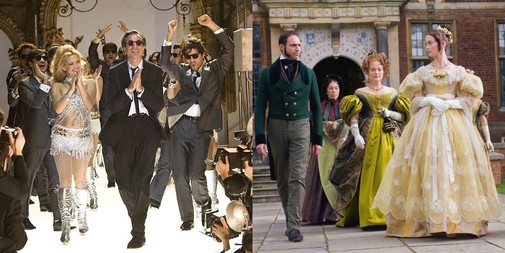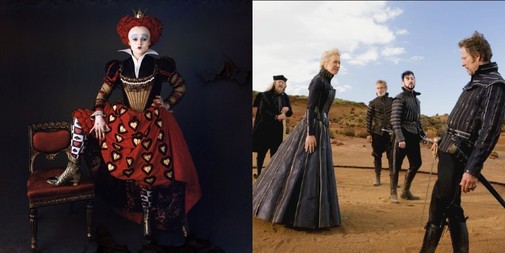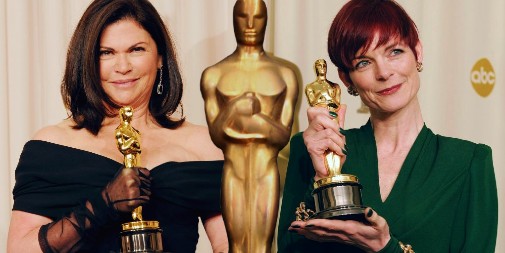
Our look back at the cinematic year of 2005 and its Academy Awards continues. This time, we're examining the work of two titanic talents who battled for the Oscar in the Best Costume Design category as they were prone to do. We're talking about the magnificent Colleen Atwood and the sublime Sandy Powell…
Oscar's current favorites, when it comes to costume designers, started their careers roughly at the same time and lived their initial brushes with the Academy at a similar point too. Powell's first nod came in 1993 when her century-spanning work in Sally Potter's Orlando earned some well-deserved attention come awards season. At that time, Powell was already internationally respected thanks to her collaborations with Derek Jarman, though none of that auteur's movies ever got close to AMPAS validation. Atwood's first nod, on the other hand, would come a year later, in 1994, for the naturalistic recreations of mid-19th century fashions in Gillian Armstrong's Little Women. Like Powell, Atwood had conquered plenty of critical admiration before the nomination, thanks, in great part, to her works with Tim Burton and Jonathan Demme.
It might seem weird to pit these two genius costume designers against each other, but that's what the Academy did repeatedly from 1998 to 2010. At a certain point, it even seemed like they could only win when the other was among their direct competition. Atwood's victory for 2016's Fantastic Beasts and Where to Find Them would break the pattern, but their parallel Oscar histories are still a bit of fascinating trivia for those who obsess about the Academy Awards. With that in mind, let's look at their six Oscar face-offs and see if we agree with AMPAS' eventual choices. In the war of Atwood vs Powell, who's the biggest winner?
- Colleen Atwood: Beloved
- Sandy Powell: Shakespeare in Love (winner) AND Velvet Goldmine
1998 truly was Sandy Powell's year. Velvet Goldmine is a masterpiece on every level, but the costumes deserve particular admiration, fusing fantasy and rock history, an array of pop references, and the esoteric glam of the underground. Shakespeare in Love is similarly theatrical, though its Elizabethan designs are a bit more grounded than Velvet's craziness. Comparatively, Atwood's 19th century looks for Jonathan Demme's Beloved feel downplayed and naturalistic, even if they're still rich in idiosyncratic detail and playful games of color, pattern, printing and odd stitching.
Verdict: Powell all the way, though not for the film that earned her the gold.
2002
- Colleen Atwood: Chicago (winner)
- Sandy Powell: Gangs of New York
Atwood's collaborations with Rob Marshall have earned a lot of Oscar recognition over the years and it's easy to see why. Her creations for Chicago toe the line between overtly theatrical razzle-dazzle and cinematic realism, between Fosse sensuality and historical glamour. Still, I often feel like she leans a bit too hard into well-worn clichés of 1920s costuming when a bit more originality would have been appreciated. That being, it's a glitzy delight overall. As for Powell, I've previously written about the genius of her work in Scorsese's Gangs of New York. Long story short, Powell's a genius and her use of color is a movie miracle of the highest order.
Verdict: In a tight race, Powell's love for wild textiles gives her the victory.
2004
- Colleen Atwood: Lemony Snicket's A Series of Unfortunate Events
- Sandy Powell: The Aviator (winner)
A Series of Unfortunate Events often feels like an attempt at doing Tim Burton by another director. In that regard, Atwood's gothic designs do their job splendidly. Jim Carrey's extravagant disguises are especially fun, and the designer's love for stripes is on full display too. Powell, however, turned in one of her most historically accurate wardrobes for Scorsese's The Aviator. Her designs evoke Hollywood's Golden Age while helping the movie's delineation of time through the change of its color palette. It's wonderful to see Powell's wardrobe getting progressively more colorful as the story moves from the washed-out two-strip processes of the 1920s to full Technicolor in the 40s.
Verdict: The Academy chose Powell and we concur.
2005
- Colleen Atwood: Memoirs of a Geisha (winner)
- Sandy Powell: Mrs. Anderson Presents
I'd like to have seen a Japanese costume designer tackling the challenge of Memoirs of a Geisha, one but can't deny that Atwood's designs are breathtakingly lavish. Instead of going for strict verisimilitude, she glammed up traditional Japanese clothing and made it feel like history philtered through the prism of Old Hollywood. Powell had a different challenge all-together, needing to suggest the reality of London during the Blitz while dreaming up theatrical styles of times gone by. Her wardrobe is so brilliant that it's often more interesting to look at the clothes than even the most ravishing displays of staged nudity offered by Mrs. Henderson Presents.
Verdict: Between these two excellent showcases, Atwood takes the win, just as she did with the Academy.
2009
- Colleen Atwood: Nine
- Sandy Powell: The Young Victoria (winner)
It's no easy feat making the disproportionate silhouettes of the 1830s and 1840s fashion look appealing to a modern audience. Still, even when faced with such a challenge, Sandy Powell triumphs. I only wish her use of color was a bit more disciplined for it often feels like the designer grew bored with the project and tried to distract herself with glitzy fabrics. Nine, on the other hand, showcases Atwood's penchant for retro stylings in splendid fashion, at the same time it puts forward a carefully curated collection of color stories and visual references. I especially love the hints of Fellini hidden among the dancers of the bigger musical numbers.
Verdict: AMPAS crowned Powell's royalty porn, but Atwood's sexy stylings win here.
2010
- Colleen Atwood: Alice in Wonderland (winner)
- Sandy Powell: The Tempest
Honestly, neither of these costuming queens deserved to be nominated in 2010. Tim Burton's Alice in Wonderland is too garish for its own good and Atwood's costumes tend to follow the rest of the movie's failings. There's a lot to love about individual costumes, but they are too much as a movie wardrobe. The Tempest, similarly, is full of interesting couture. However, for every inspired design, there's another Powell-created flight of fancy that doesn't work. In both films, the designer's odd takes on Elizabethan fashion (a torrent of red for Atwood and anachronistic zippers for Powell) are the highlights.
Verdict: Atwood wins out in this lackluster face-off.
Who'd have you voted for, between Atwood and Powell, in these six years?
